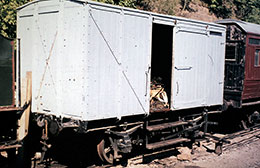
 |
||
LMS 12 TON VAN No. 98543 HISTORY
Owned by 2857 Society from 1974 to 1982
 At the formation of the LMS in 1923, Midland Railway practice predominated, and many of the designs for the new company were in fact up-dated versions of existing MR types. In 1924 no less than 18,264 new wagons were built. A similar rate of construction was maintained until the end of 1930, by which time a total of 106,000 wagons of LMS design had entered service.
At the formation of the LMS in 1923, Midland Railway practice predominated, and many of the designs for the new company were in fact up-dated versions of existing MR types. In 1924 no less than 18,264 new wagons were built. A similar rate of construction was maintained until the end of 1930, by which time a total of 106,000 wagons of LMS design had entered service.
The majority of the wagons built by the LMS for ordinary goods traffic had a carrying capacity of twelve tons, and were 17'6" long over headstocks. They were mounted on four wheels, the wheelbase on those built up to 1930 being 9'0", thereafter increased in the majority of cases to 10'0". The third highest total, after coal and mineral types, was achieved by the covered goods vans. These all had steel underframes, the majority having wooden bodies, though some steel bodied examples appeared, while corrugated steel ends also featured on much of the construction. 11,770 covered goods wagons were produced during the period 1924-30.
In December 1974 an observant Bewdley volunteer spotted recently withdrawn van No. DM98543 in Stourbridge yard. It has been suggested that this standard LMS 4-wheeled box van with sliding doors was to LMS Diagram 1676 and built at Wolverton in 1924, and indeed the running number 98543 would tend to support that view. However the LMS numbering seems to have been fairly random and the end diagonal bracing in the centre panel and the complete absence of ventilators points more to diagram 1664. There were 2,544 of this D1664 type of van built between 1924-26 at Derby and Wolverton. Van 98543 was not vacuum brake fitted; vacuum brakes were only fitted to a relatively small number of vehicles.
After purchase of the loco, by the end of 1974 the Society bank balance had risen back up to £300-00 and speedy enquiries revealed BR were asking only £280-00 plus a mere £18-00 to have 98543 delivered the few miles down the line from Stourbridge to Bewdley. This was a pretty extravagant purchase considering it virtually wiped out the funds primarily destined for moving the loco to the SVR, but negotiations were completed by Christmas and the van arrived on 18th January 1975, the first item of Society rolling stock on the SVR. A set of non-authentic steps was added each side to give ground-level access to the doors. Some crude shelves were installed inside and these were rapidly filled with items which had been removed from 2857 in Barry for safe keeping, together with other spare loco parts and the primitive beginnings of our collection of tools, whereupon the shelves promptly collapsed! A new roof canvas was fitted and a sturdier set of shelves was constructed. As it was obviously much more exciting to restore 2857 herself, work on the van was slow and the coat of LMS grey was not applied until around June 1977, when it was reported to look “presentable but still awaited the services of a signwriter”. It was also found to have a cracked tyre, though as a static storage vehicle this was simply ignored!
In October 1981 the 2857 Society decided to up-grade their workshop, storage and messing facilities and purchased GWR Collet Bow-Ended Coach 5043, which rendered both the LMS 12-ton box van and the ‘Pooley Van’ redundant. These two were sold to the ‘48518 Preservation Society’ based at Buxton on the Peak Rail scheme, arriving there on 19th February 1982, together with a spare Stanier tender belonging to the SVR Co, which had been stored at Highley. The ‘48518 Preservation Society’ subsequently transferred their attention to 8F 2-8-0 No. 48624, now at the GCR, while No. 48518 ended up being cannibalised for spares for other locomotives.
The original Peak Rail Society were prevented by BR from accessing the line out of Buxton, so after a number of years, rather than stick it out, they moved to another site on the same railway and sold most of the original site to Buxton Water to be a bottling plant, but retained the station area and approach. By August 1992 Van 98543 was the last vehicle remaining on the site at Buxton and is recorded as having been sold or scrapped, actual scrapping sadly probably taking place later that year.
© 2857 Society 2007-2019